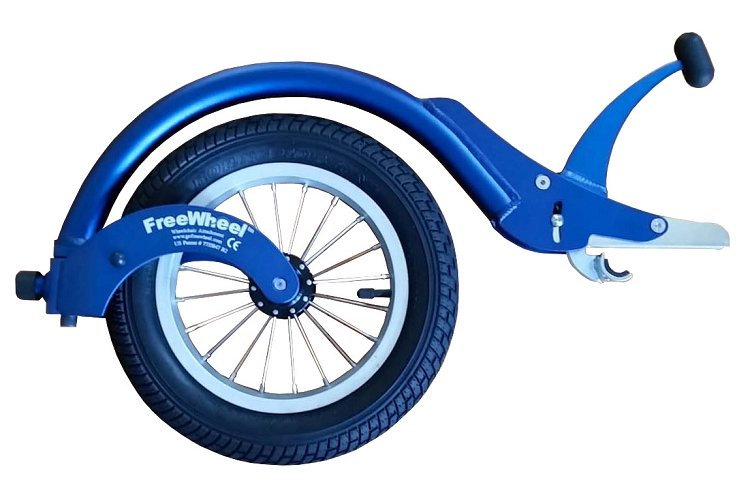What is the FreeWheel?
The FreeWheel is a wheelchair attachment for rigid frame or folding manual wheelchairs with a footrest below 4-3/4″ and a footrest angle less than 12%. It attaches to the front of the wheelchair, lifting the wheelchair’s casters off the ground so it becomes a three-wheeler, allowing it to move across surfaces it otherwise couldn’t.
Who is the FreeWheel for?
According to a 2015 study from the Stanford Woods Institute for the Environment, walking or hiking in nature has mental health benefits and can even reduce the risk of depression — and that’s just one example of the many studies and analyses that quantify something many of us innately know: connection to nature is important for the human spirit. For the 13.7 percent of disabled adults with limited mobility, hiking is a fairly inaccessible hobby — especially for those who use wheelchairs some or all of the time. The FreeWheel is one device that makes activities like hiking significantly more accessible; I first learned about it in a blog post by Marcy Marchello on a blog called Everyone Outdoors, which focuses its content on outdoor recreation from an accessibility angle. The FreeWheel is one of many pieces of assistive technology recommended on the blog; there are also special power wheelchairs that are especially made to be conducive to hiking and other activities done on uneven surfaces. I chose to focus on the FreeWheel because, relative to other options, it comes at an accessible price point. It’s certainly still expensive at $899 (although, at the time of writing, all three colors are on sale for $649). But when the alternatives come at a cost of multiple thousands, it’s a less pricy option. Most importantly, it functions well: “[The FreeWheel] allows for much less strenuous travel on mild and moderate terrain with irregular surfaces such as eroding or inconsistent pavement, grassy areas, gravel, wood chips, curbs, dirt roads, transitions between pavement and grass, etc.,” writes Marchello. She also mentions that good candidates for the FreeWheel would be wheelchair users with upper body mobility and arm strength, so it’s not a good option for folks who are paraplegic or otherwise have particularly limited upper body mobility. It’s also, of course, not a good option for wheelchair nonusers.
What models of accessibility does the FreeWheel correspond to?
The FreeWheel is, of course, an attachment made for a wheelchair — and actually, the question of which model of disability the wheelchair aligns with stumps me. It could be argued that the wheelchair fits in with the medical model because it puts the burden on the individual who needs the wheelchair: That individual is responsible for purchasing and taking care of the wheelchair and for figuring out how to navigate it through spaces that are more often than not designed for able-bodied pedestrians.
It could also be argued, in alignment with the social model, that the wheelchair’s purpose is to lessen the disabling conditions that society has produced, like the unnecessarily far distance between one place and another or the lack of public seating in many of the spaces we occupy.
So what about the FreeWheel? Since it was invented to expand the abilities of an existing piece of accessibility technology — and because it is primarily used on surfaces that are inherent to the natural world, not necessarily human-designed, I’m not sure it fits squarely into the social model of disability. It’s not totally aligned with the medical model, either, since it’s an accessory to improve an existing piece of technology. The first model that comes to mind when I consider the FreeWheel is actually the functional solutions model, under which the focus isn’t really to place blame on the individual or on society; instead, the functional model of disability, according to a lecture by Prof. Nicholas Dease for his class, Digital Accessibility, at the Pratt Institute, “identifies impairments or limitations as they affect our ability to complete tasks,” and “aims to eliminate these limitations through advancements in technology.” If we consider a hike a task — or even if we don’t, since the FreeWheel would be useful for a landscape designer who uses a wheelchair, or a gardener who uses a wheelchair — then that perfectly describes the FreeWheel’s purpose. Wheelchairs are traditionally limited to smooth, flat surfaces, which impairs a wheelchair user who wants to move across rocky, sandy, or otherwise uneven surfaces. The FreeWheel is a technological advancement which eliminates that limitation.
What are some features of the FreeWheel?
Shim: The shim is the component that attaches the FreeWheel to the wheelchair. It gets attached to the footrest, and the standard version of the FreeWheel fits a footrest height of between 3.75-5.75 inches. They also make custom FreeWheels in four other sizes. But if your wheelchair’s footrest isn’t within that range, then you can’t use the FreeWheel. The FreeWheel also has a custom attachment that makes it usable with foldable wheelchairs.
Frame & Fork: The frame and fork that hold the wheel are made with aircraft quality aluminum, which means it’s lightweight and rust resistant, but can corrode.
Wheel: The wheel is much larger than the typical front caster wheels, and is wide and durable — like the tire on a mountain bike. It also has a “detent” mechanism that “keeps the front wheel straight to improve stability and handling.”
